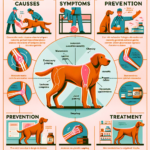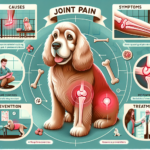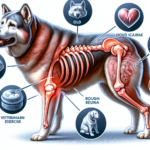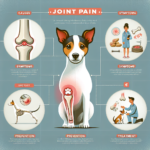Wirehaired Vizsla Joint Pain: Causes, Symptoms, Prevention, and Treatment

Introduction
The Wirehaired Vizsla is a versatile and energetic breed known for its hunting prowess and affectionate nature. Originating from Hungary, this breed was developed by crossing the Hungarian Vizsla with the German Wirehaired Pointer to create a dog with a more robust coat suitable for harsh weather conditions. Wirehaired Vizslas are medium-sized dogs with a distinctive wiry coat, expressive eyes, and a keen sense of smell, making them excellent hunting companions and family pets.
Like many breeds, Wirehaired Vizslas are prone to certain health issues, with joint pain being a significant concern. Joint health is crucial for this breed due to their active lifestyle and working background. Ensuring the well-being of their joints can help maintain their quality of life and prolong their active years.
Breed-Specific Joint Pain Risks
Genetic Predisposition
Wirehaired Vizslas, like many other breeds, have a genetic predisposition to joint-related issues. Common conditions include hip dysplasia, elbow dysplasia, and arthritis. Hip dysplasia is a hereditary condition where the hip joint does not fit properly into the hip socket, leading to pain and mobility issues. Elbow dysplasia involves abnormal development of the elbow joint, causing lameness and discomfort. Arthritis, a degenerative joint disease, can also affect Wirehaired Vizslas, leading to chronic pain and stiffness.
Age-Related Risks
As Wirehaired Vizslas age, the risk of developing joint pain increases. Typically, signs of joint issues may start to appear in middle age, around 5-7 years old. However, some dogs may show symptoms earlier or later, depending on their genetic makeup and lifestyle. It’s essential to monitor their joint health as they age and take preventive measures to mitigate the risks.
Activity Level and Joint Stress
Wirehaired Vizslas are known for their high energy levels and love for physical activities such as running, hunting, and playing. While regular exercise is vital for their overall health, excessive or high-impact activities can put stress on their joints, leading to wear and tear over time. Owners should balance their dog’s activity levels to ensure they get enough exercise without overburdening their joints.
Common Symptoms of Joint Pain in Wirehaired Vizslas
General Symptoms
- Limping or favoring one leg
- Stiffness, especially after rest or sleep
- Reluctance to jump, run, or climb stairs
- Decreased activity or interest in play
- Swelling around the joints
- Whining or showing signs of discomfort when touched
Breed-Specific Symptoms
While the general symptoms of joint pain are similar across breeds, Wirehaired Vizslas may exhibit specific signs due to their active nature. Owners might notice a decrease in their dog’s enthusiasm for hunting or outdoor activities, or a reluctance to engage in high-energy play sessions. Additionally, their wiry coat may make it harder to detect swelling, so careful observation is necessary.
When to Consult a Vet
If you observe any of the above symptoms in your Wirehaired Vizsla, it’s crucial to consult a veterinarian promptly. Early diagnosis and intervention can significantly improve the prognosis and quality of life for dogs with joint pain. Regular veterinary check-ups are also essential for monitoring joint health and catching any issues early.
Preventive Measures for Joint Health
Exercise Recommendations
Regular, moderate exercise is key to maintaining joint health in Wirehaired Vizslas. Activities such as walking, swimming, and controlled play sessions are excellent choices. Avoid high-impact exercises like excessive running or jumping, which can strain the joints. Tailor the exercise routine to your dog’s age, fitness level, and any existing joint issues.
Dietary Suggestions
A balanced diet rich in essential nutrients can support joint health. Consider incorporating foods or supplements that contain glucosamine, chondroitin, and omega-3 fatty acids, which are known to promote joint health and reduce inflammation. Consult your veterinarian for specific dietary recommendations tailored to your dog’s needs.
Weight Management
Maintaining a healthy weight is crucial for reducing joint stress. Excess weight can exacerbate joint issues and lead to more severe pain and mobility problems. Monitor your dog’s weight regularly and adjust their diet and exercise routine as needed to keep them at an optimal weight.
Early Screening and Monitoring
Regular veterinary check-ups and early screening for joint issues can help catch problems before they become severe. Discuss with your vet about breed-specific screening tests, such as X-rays or genetic testing, to identify any predispositions to joint conditions. Early intervention can make a significant difference in managing joint health.
Treatment Options for Joint Pain
Non-Surgical Treatments
Non-surgical treatments for joint pain in Wirehaired Vizslas include medications, physical therapy, and lifestyle adjustments. Anti-inflammatory drugs and pain relievers can help manage symptoms, while physical therapy can improve mobility and strengthen muscles around the joints. Lifestyle changes, such as modifying exercise routines and providing supportive bedding, can also alleviate joint pain.
Surgical Options
In severe cases, surgical intervention may be necessary. Common surgeries for joint issues include hip replacement, arthroscopy, and joint fusion. These procedures can significantly improve the quality of life for dogs with debilitating joint pain. Consult with a veterinary orthopedic specialist to determine the best surgical option for your dog.
Alternative Therapies
Alternative treatments such as acupuncture, hydrotherapy, and massage can also benefit Wirehaired Vizslas with joint pain. Acupuncture can help reduce pain and inflammation, while hydrotherapy provides low-impact exercise that strengthens muscles without stressing the joints. Massage therapy can improve circulation and alleviate muscle tension around the affected joints.
Lifestyle and Management Tips
Daily Care Routine
A consistent daily care routine can help manage joint pain in Wirehaired Vizslas. This routine might include gentle exercise, administering medications or supplements, and providing a comfortable resting area. Regular grooming and monitoring for any changes in mobility or behavior are also essential components of daily care.
Modifying the Home Environment
Making adjustments to your home environment can significantly improve the comfort of a dog with joint pain. Consider installing ramps to help them navigate stairs, providing orthopedic beds for better support, and ensuring that their living area is free of slippery surfaces that could lead to falls.
Long-Term Management
Long-term management of joint pain involves a combination of regular veterinary care, appropriate exercise, a balanced diet, and a supportive home environment. Consistent monitoring and adjustments to their care routine can help keep your Wirehaired Vizsla active and happy despite joint pain.
FAQs About Wirehaired Vizslas and Joint Pain
What are the early signs of joint pain in Wirehaired Vizslas?
Early signs include limping, stiffness, reluctance to move, and decreased activity levels. If you notice any of these symptoms, consult your veterinarian for a thorough examination.
Can joint pain in Wirehaired Vizslas be prevented?
While genetic predispositions cannot be entirely prevented, maintaining a healthy weight, providing a balanced diet, and ensuring regular, moderate exercise can significantly reduce the risk of joint pain.
Are there specific supplements that can help with joint health?
Yes, supplements containing glucosamine, chondroitin, and omega-3 fatty acids are known to support joint health. Consult your veterinarian for recommendations on the best supplements for your dog.
When should I consider surgery for my dog’s joint pain?
Surgery is typically considered when non-surgical treatments are no longer effective, and the dog’s quality of life is significantly impacted. A veterinary orthopedic specialist can help determine the best course of action.
How can I make my home more comfortable for a dog with joint pain?
Consider installing ramps, providing orthopedic beds, and ensuring that your home is free of slippery surfaces. These modifications can help reduce joint stress and improve your dog’s comfort.
Conclusion
Joint pain is a common concern for Wirehaired Vizslas, but with proper care and preventive measures, it can be managed effectively. Regular veterinary check-ups, a balanced diet, appropriate exercise, and a supportive home environment are crucial for maintaining joint health. By staying vigilant and proactive, you can help ensure that your Wirehaired Vizsla enjoys a happy, active life despite any joint issues.
Remember to consult your veterinarian regularly to monitor your dog’s joint health and make any necessary adjustments to their care routine. With the right approach, you can help your Wirehaired Vizsla live a comfortable and fulfilling life.




